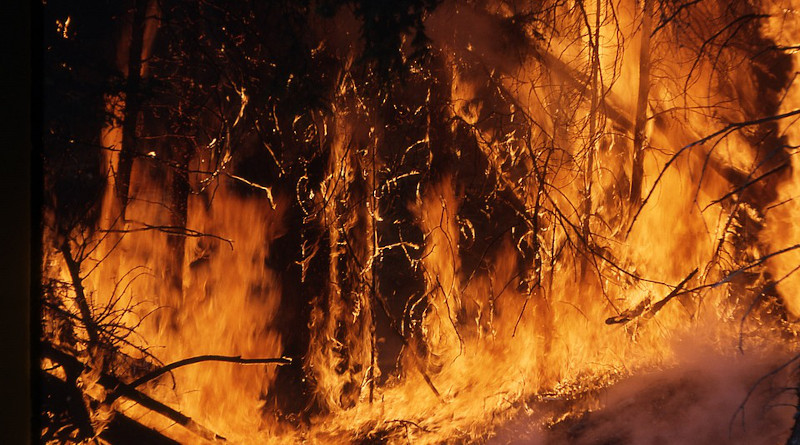Extreme Weather Requires An Extreme Response – OpEd
By Arab News
By Chris Doyle*
As Turkish President Recep Tayyip Erdogan toured the scenes of devastation caused by wildfires in Marmaris, he gently lobbed boxes of tea from his bus door to those affected. No doubt he meant well, but this encapsulated the global political reaction to extreme weather events and climate change. The leaders know the problem is at the catastrophic end of the spectrum, but are still engaged in wishful thinking, tossing out random pledges whenever the need arises.
Tracking all the extreme weather events around the globe, one has to wonder whether this term will have to be changed. At what stage do extreme weather events become lethal but normal weather events? Is moderate weather going to become a rarity? Some extreme events will have major impacts on human life, others less so, but they are all part of a pattern.
Let us look at the tally of the last few weeks alone. Floods are not just restricted to countries such as Bangladesh, where they are occurring right now. Images are still fresh from the huge floods in Germany, Belgium and the Netherlands, while London endured flash flooding at the end of July. Towns on the wonderful Lake Como in northern Italy suffered major mudslides and flooding. Italy has also suffered a huge increase in major hailstorms, with the latest in Bologna producing blocks of ice the size of tennis balls. China has also suffered biblical-style floods, with eight months’ worth of rain falling on Zhengzhou in one day. Also in July, a reported 150 people died in flash flooding in northeastern Afghanistan. The monsoon rains in western India also killed more than 100 people.
Flooding is increasing because warmer air can carry more water. Scientists also predict that, in some areas, although flooding and huge rainstorms may increase, overall precipitation may decrease — it will just be more sudden.
Meanwhile, wildfires are becoming roaring monsters. The largest current fire in the US, in Oregon, has lasted since July 6. The far east of Russia has suffered more than 200 fires. Turkish firefighters have their hands full, with dozens of wildfires that have so far killed at least eight people. The inhabitants of Catania are used to having to be wary of Mount Etna erupting, but Sicilian firefighters are currently struggling to contain numerous fires threatening the city. None of this is mere happenstance.
Heat records are being broken with more frequency than Olympic records. And it is not that they are just hotter, but they are also lasting longer. The Middle East may be used to extreme temperatures to an extent, but western Canada saw the mercury topping 49.6 degrees Celsius this summer. This did not just break the record, it smashed it by 5 C. The town where this was recorded was subsequently almost wiped out by wildfires. New highs have also been set in Turkey, Finland and Estonia, among others. The US has just recorded its hottest June in more than a century, while 95 percent of the west of the country is suffering from drought.
Can a single individual example of extreme weather be definitively attributed to climate change? No, of course not. However, the frequency and patterns of such events clearly can, and on this the scientific community is increasingly both united and alarmed.
The alarming issue for those paying attention is that the top-level climate change modeling appears to have underestimated the impact. The scale of the modeling challenge is daunting, not least due to the variables in the global climate, such as the El Nino phenomenon and the weakening of the jet stream across the Atlantic. Predicting wind patterns or even changes in wave heights is extremely challenging. But you cannot understand floods or wildfires in isolation. They are often what are now termed “compound events.” Every aspect of the climate and what is affecting it has to be understood and there are often not the historical records to produce credible data. If the scientists are seen to press the panic button too soon, they lose credibility. When they underestimate the issue, they get the blame.
One has to wonder what it is that more world leaders and public opinion formers need to see before they start to consider not just action, but drastic action. Extreme events require extreme remedies. These need to be backed by research, effort and investment. Political will and courage needs to be overflowing and focused.
One way to convince politicians, big business and the public worldwide is to demonstrate the financial costs. This is what makes the world go round. For example, the floods in Henan in China are estimated to have caused $14 billion of damage. Insurers have largely been in the advance guard of doom-mongers on this issue, but other business sectors will join in the demand for extreme action. Farmers lose out due to major hailstorms that ruin crops, especially delicate fruit. The changing duration and timing of the seasons also affect crop production. Increasing temperatures lead to soil drying out and even desertification.
Countries have to start preparing. This is not going to go away. Wildfires will need to be contained and people will have to adapt their way of life to extreme heat. We should be more hesitant in building on flood plains. One district of Hamburg is being developed on raised plinths, with the ground floors of all buildings capable of being sealed. Such methods may have to be adopted elsewhere. We have to ditch the lazy thinking that these are weird and bizarre events that happen elsewhere because, as the scientists have been telling us, such disasters can and will happen anywhere.
Perhaps we should see these events as disaster warnings from the planet. We must act now.
- Chris Doyle is director of the London-based Council for Arab-British Understanding (CAABU). Twitter: @Doylech

